Key takeaways:
- Engaging with underserved communities requires empathy, understanding, and building genuine connections through trust and shared experiences.
- Effective outreach in campaigns must prioritize meaningful engagement, enabling marginalized voices to shape policies and fostering a sense of belonging in the political process.
- Tailoring messages to specific community needs and using relatable language enhances connection and communication, making individuals feel seen and valued.
- Measuring the impact of community strategies involves both quantitative data and personal testimonials, highlighting the importance of human connections over mere statistics.
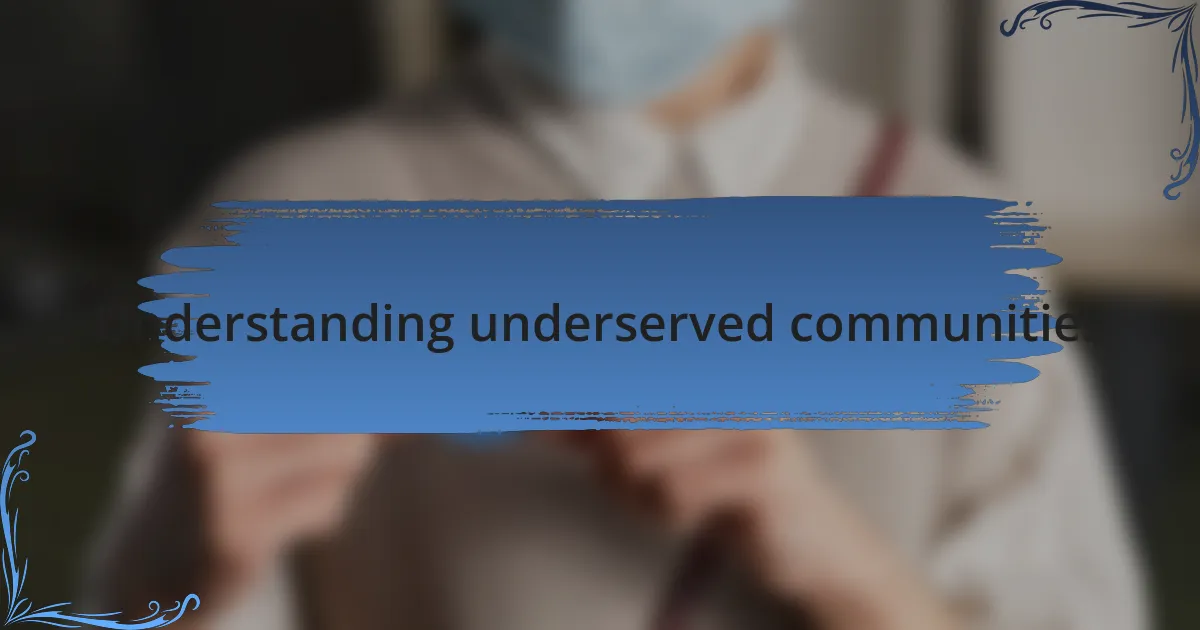
Understanding underserved communities
Understanding underserved communities requires recognizing the unique challenges they face, such as limited access to essential services, economic opportunities, and even legal representation. I remember the first time I stepped into a community center in a low-income area; the struggles of the people echoed through their stories, revealing how deeply systemic barriers shape their lives. I often find myself wondering: What would it take for someone in a forgotten neighborhood to feel truly seen and heard?
In my experience, underserved communities are often characterized by a rich tapestry of cultures and experiences that are overlooked. For instance, I volunteered at a local food bank where I met a mother who juggled multiple jobs, all while grappling with issues of transportation and childcare. It made me reflect on how easy it is to forget that behind every statistic lies a personal story—a person striving for a better life amidst adversity.
Talking to individuals directly within these communities has opened my eyes to the importance of building trust. There’s something powerful about sitting down and sharing a meal with someone, listening to their hopes and fears. It raises an important question: How can we create genuine connections that empower these individuals? My belief is that it starts with empathy, understanding, and a commitment to break down the barriers that isolate them.
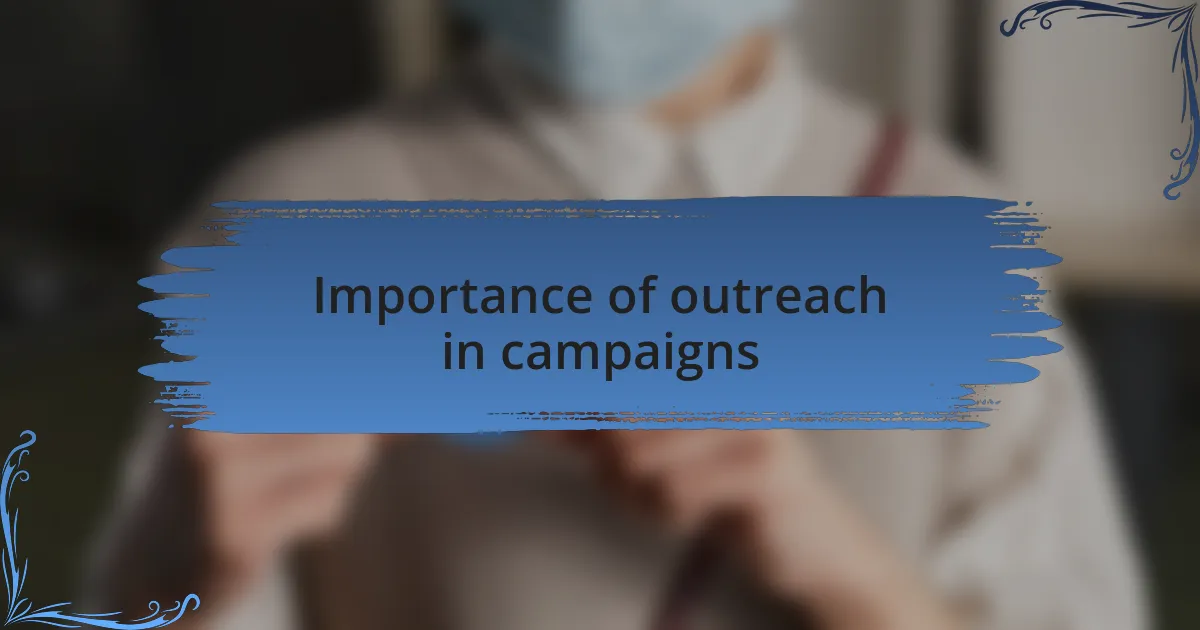
Importance of outreach in campaigns
Outreach in campaigns is crucial, particularly for connecting with underserved communities who often feel overlooked. I recall a town hall event where I had the chance to speak directly with residents about their concerns. Their feedback highlighted how vital it is for campaigns to create platforms that amplify these voices. If outreach isn’t a priority, how can we claim to represent all our constituents?
When I think about the campaigns that have genuinely made an impact, I see a consistent thread: they prioritize meaningful engagement. During a local initiative I helped organize, we knocked on doors and invited people to share their stories. The excitement was palpable as community members began to feel their opinions truly mattered. Wouldn’t you agree that such interactions foster a sense of belonging and ownership in the political process?
Moreover, outreach sets the foundation for building trust, which is often lacking in these communities. I once joined a community advisory board where marginalized voices were brought to the table to shape policies. The experience was eye-opening; it became clear that outreach must go beyond mere outreach events. It’s about cultivating relationships that empower these communities to advocate for themselves. How can we hope to bring about change if we don’t first establish that trust?
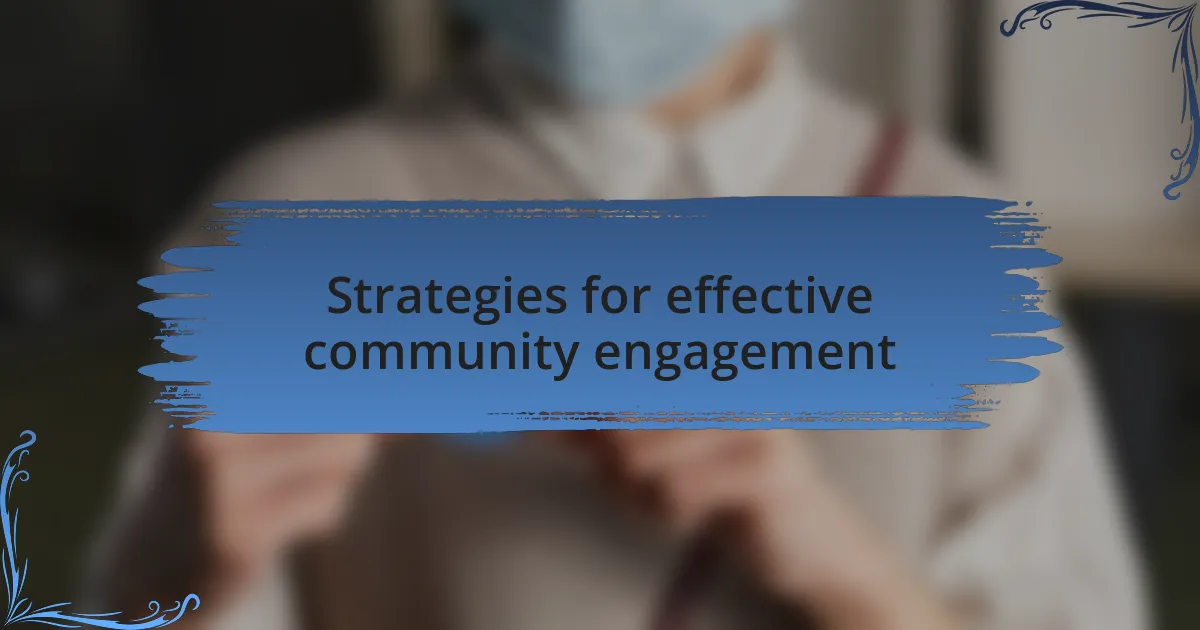
Strategies for effective community engagement
Engaging effectively with underserved communities requires transparency and genuine dialogue. In my experience, hosting informal coffee chats at local cafes can break down barriers and encourage openness. I remember a time when I shared my own journey with a group of residents; their walls came down, and we had meaningful conversations that allowed them to express their needs without hesitation. Isn’t it amazing how a simple setting can transform the way people communicate?
Another strategy is to incorporate creative outreach methods that resonate with the community’s culture. For example, during a community event I coordinated, we used art installations that depicted local issues, inviting residents to contribute their thoughts. The response was overwhelming; people were not only keen to talk but also engaged in the artistic process. Isn’t it fascinating how creativity can bridge gaps and foster connection?
Listening is perhaps the most crucial element of community engagement. On one occasion, I facilitated a listening circle where community members shared their stories uninterrupted. What struck me was how powerful it was to let them speak freely, without immediately jumping in to provide solutions. This approach not only validated their experiences but also nurtured a sense of collective empowerment. How often do we overlook the simple power of just listening, when that can be the first step toward action?
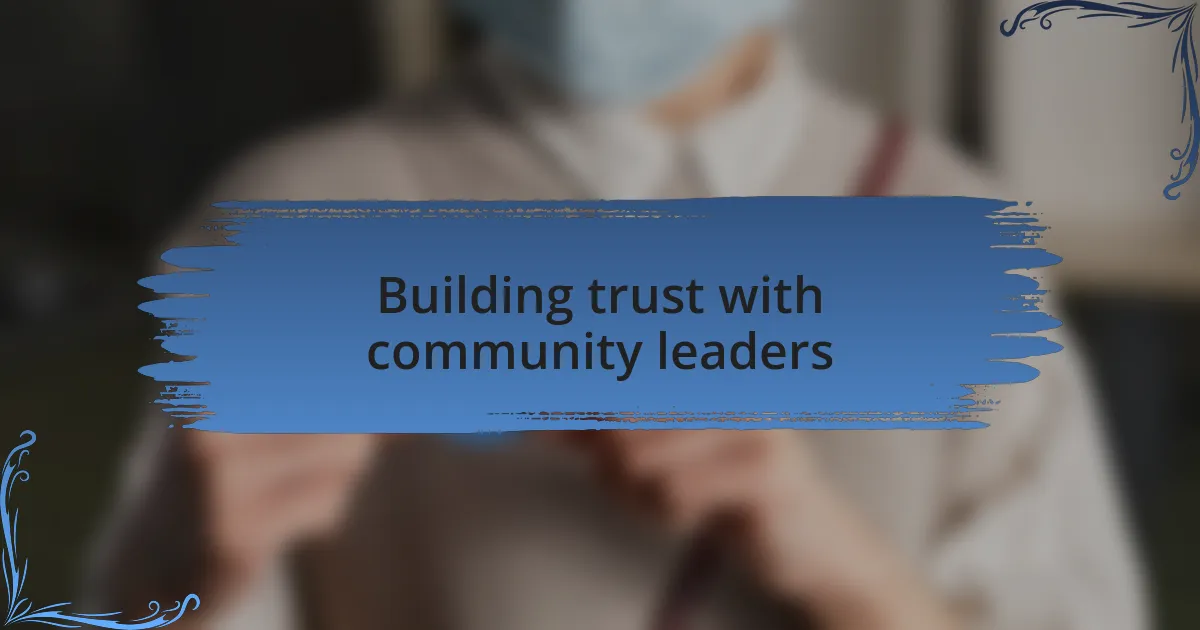
Building trust with community leaders
Building relationships with community leaders is a vital step in establishing trust. I recall a time when I reached out to a local leader whose community had been historically marginalized. Rather than approaching with a formal agenda, I invited them for a walk in the park. During that simple stroll, we shared our backgrounds and aspirations. This laid the groundwork for mutual respect and understanding. Isn’t it true that sometimes an informal setting can reveal more about people than a boardroom ever could?
Another experience that stands out to me was when I attended a community meeting organized by a leader I had just met. Instead of directing the conversation, they encouraged everyone to share their views on pressing issues. I was struck by their commitment to listen rather than dominate the dialogue. That atmosphere of openness made a lasting impression on the attendees, including myself. How often do we underestimate the power of a leader who prioritizes listening over lecturing?
In my opinion, consistency is key in building long-term relationships with community leaders. I’ve found that when I regularly check in with leaders, it reinforces our partnership and reinforces trust. One winter, I started a monthly newsletter specifically aimed at community leaders to keep them informed about local developments. This small yet impactful gesture not only provided valuable insights but also sparked ongoing conversations. Doesn’t it feel great when communication becomes a two-way street?
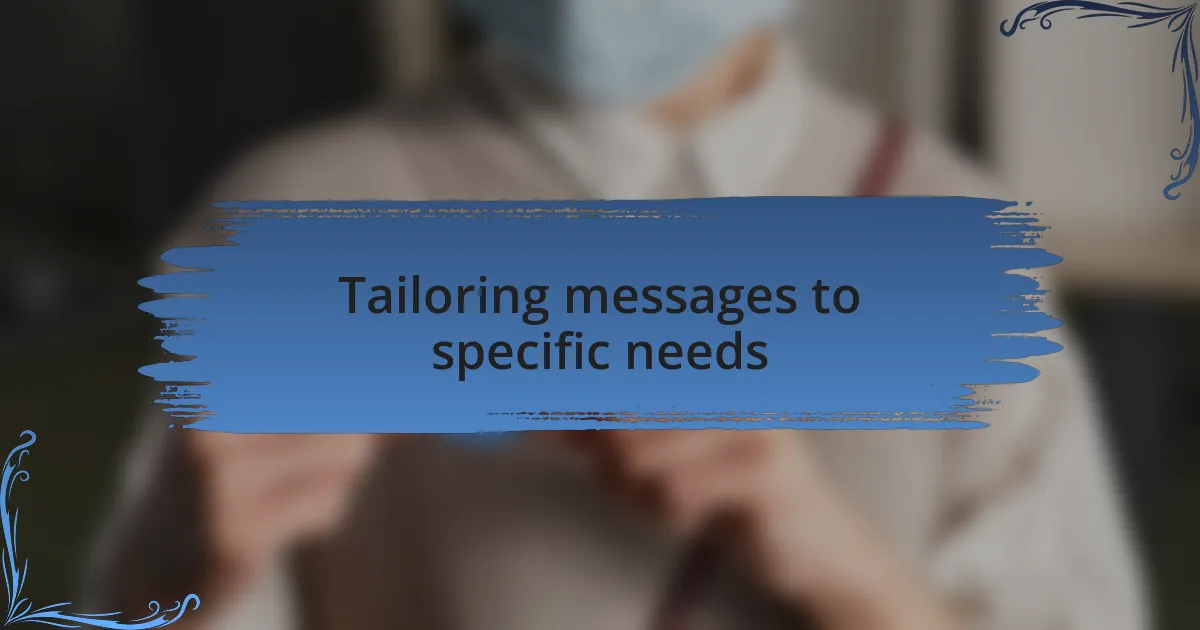
Tailoring messages to specific needs
Tailoring messages to resonate with underserved communities requires a keen understanding of their unique challenges and cultural nuances. I once took the time to study the local issues affecting a neighborhood where I aimed to connect. By crafting my message around their specific needs, like affordable housing and access to healthcare, I found that the community felt heard and acknowledged. How powerful is it when our words mirror the realities others face?
In another instance, I worked with a group focused on youth engagement in a historically overlooked area. Instead of standard political rhetoric, I chose to speak directly about opportunities for education and employment that spoke to their aspirations. I remember their faces lighting up when they realized someone was genuinely reflecting their hopes back to them. Isn’t it incredible how a few carefully chosen words can bridge the gap between ideals and experiences?
I also believe that using relatable language is vital when communicating with these communities. Once, I shared a personal story about overcoming obstacles that echoed their struggles. The connection was immediate; it transformed our exchange from a monologue into a meaningful dialogue. Have you ever noticed how vulnerability can open doors that polished speeches cannot?
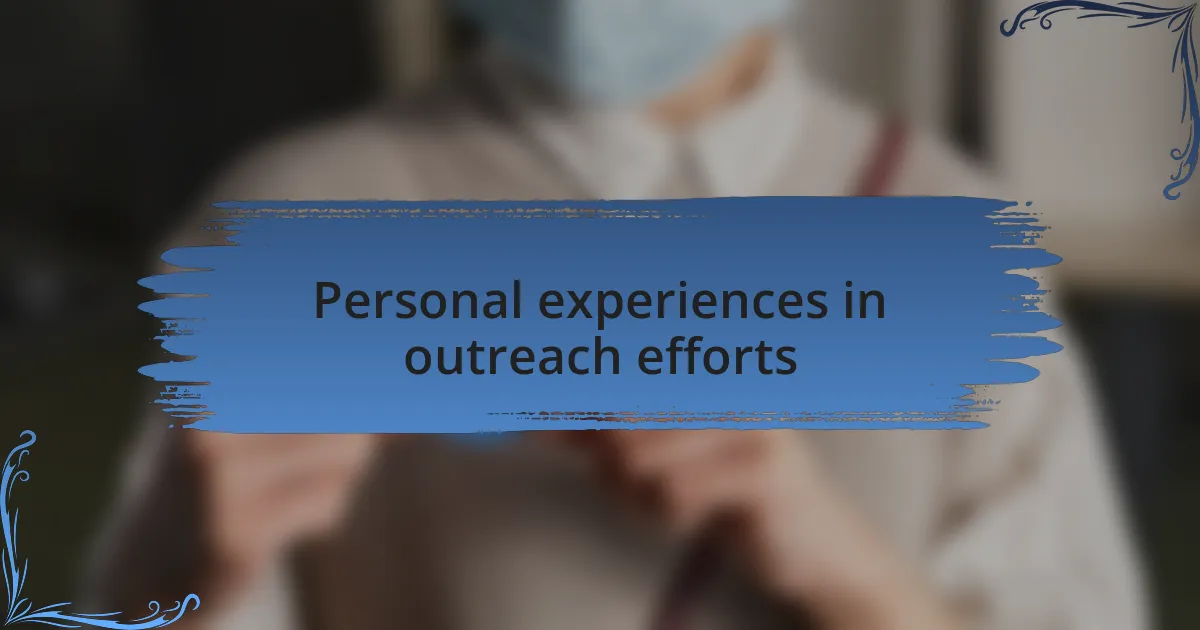
Personal experiences in outreach efforts
Reaching underserved communities has often meant stepping out of my comfort zone. During one outreach event, I found myself at a local fair, surrounded by people who had been skeptical of political engagement. Instead of pitching my campaign, I started by asking about their daily lives and concerns. I listened intently. That genuine interaction transformed the atmosphere; people opened up, and I learned about their frustrations with local services. Isn’t it amazing how simply showing up and listening can turn indifference into engagement?
I vividly recall a community workshop where I offered resources on legal rights related to housing issues. As I shared stories of individuals who bravely stood up against eviction, I could see the fear in their eyes morph into determination. They began to share their experiences, and it dawned on me—the collective power of shared stories can ignite hope and activism. Have you ever witnessed how owning our narratives can empower entire communities?
One particularly impactful moment happened while volunteering at a local health fair. I was discussing access to healthcare when a young mother approached me in tears, overwhelmed by navigating the system. Instead of advising from a distance, I sat down with her and explored options together, creating a supportive environment. This connection not only provided her immediate relief but reinforced my belief in the importance of compassionate outreach. What could be more rewarding than being a beacon of support in someone’s hour of need?
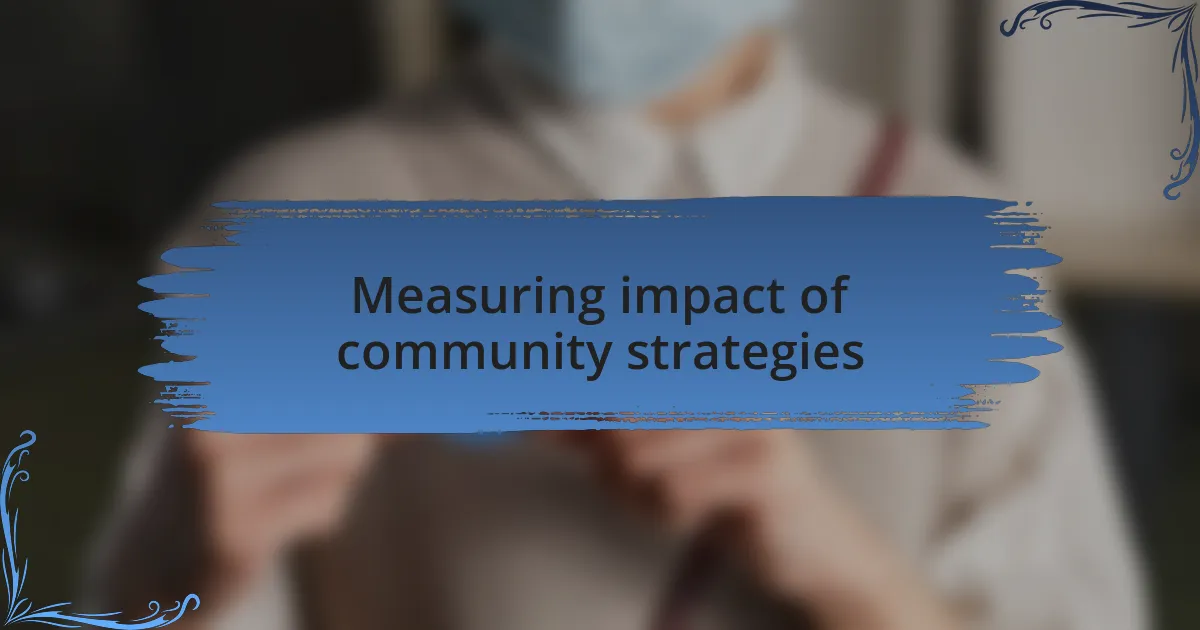
Measuring impact of community strategies
Measuring the impact of community strategies often begins with gathering qualitative and quantitative data. For instance, I once organized a follow-up survey after a series of workshops to assess changes in participants’ understanding of their legal rights. The shift in responses was telling; many indicated feeling more empowered to seek help, which underscored the value of our outreach efforts. Isn’t it fascinating how numbers can often reveal the depth of human experience?
In another project, I collaborated with local schools to encourage students to engage with civic leaders. We tracked attendance and engagement levels before and after our interactions with these leaders. The numbers showed a significant increase in participation in community events, fueling my belief that creating spaces for dialogue truly makes a difference. Have you ever noticed how those small interactions can gradually become stepping stones for greater involvement?
I’ve also found that personal testimonials can be a powerful tool in measuring impact. After one community event, several attendees reached out to share how our conversation influenced their decisions regarding legal assistance and advocacy. Those emotional responses brought home the message that our work resonates deeply, sometimes in ways we don’t immediately see. How can we quantify the value of a single life changed, or a story shared? It’s a reminder that impact isn’t just about statistics; it’s about the human connections we foster along the way.